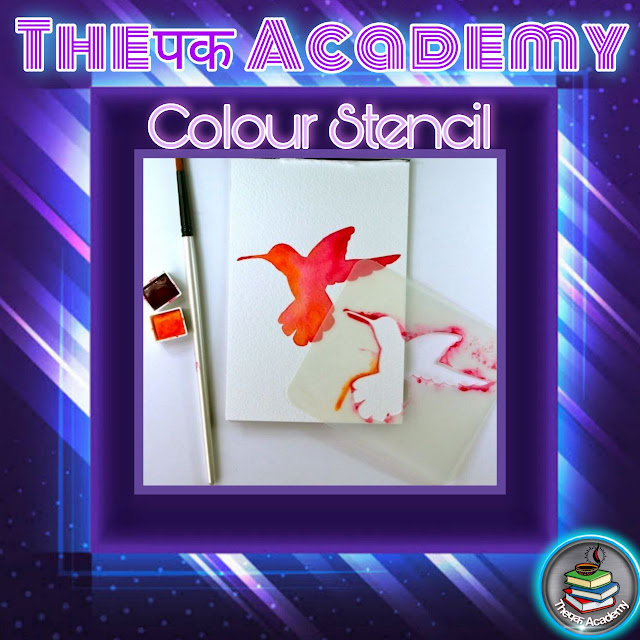Introduction:-
Stencil making involves cutting a design through a thin sheet and then transferring colour on to the surface to printed through the cut out of the design. Printing with the help of stencils is one of the basic fabric ornamentation technique. This is on art through which designing , printing and decoration can be experimented on different materials apart from fabrics. In this chapter, you will learn about the technique of making stencils and equipments required for it.
Historical background:-
Stenciling technique is an ancient art which is said to have started in china and Japan and was one of the widely used method of printing. North americans were amongst the first to start ways by which the stencils could be used in home decoration.
In the 18th century, American wallpaper was considered to be a luxury which only the wealthy could afford. However, the people soon found out that with a little imagination and patience, and by repeating the same motif again and again they could achieve a uniform overall patterns just as good as the one produced by fine printing techniques.
The arifin of this technique in India can be traced to the gupta period ( 6th to 8th century ) though even before the gupta period, this process was used in the execution of paintings.
During the Mughal and rajput periods the use of stencils for the decoration of textile material was very popular.
1.Materials and tools requested:-
The material for making a stencil should be thin and easy to cut. The following materials may be used for this purpose:
- Cartridge sheet
- Ivory sheet
- Bond paper
- Discarded photographic film nagatives
- Discarded x - ray film
- Plastic sheets
2. Devices for cutting stencils:-
- Paper cutter
- Stencil cutting knife
- Scissors
- Razor blades
- Metal ruler ( for cutting straight lines)
3. Colours for printing with stencils:-
There is wide variety of colours ranging from modern synthetic colours to most primitive traditional variety of colours. Some of there will now be briefly described.
1. Poster colours:-
These are water soluble colours which are available in a wide range of shades in liquid form. They are best used on wood, the application of several coats of polyurethane clear varnish, after the print is quite dry, will render it waterproof and hard wearing as well as increasing the brilliance of the colours.
2. Acrylic colours:-
These are also water soluble and quick drying colours which are available in a wide range of shades in liquid form they also are best used undiluted and may be used to decorate wood using the same procedure as for poster colours.
3. Fabric colours:-
They are usually fixed by ironing the printing fabric from the back side with a not iron. Fabric colours can also be sprayed and can be used on fabrics for stenciling and they produce a very subtle shade.
4. Acramin pigment colours:-
Acramin pigment colours are not soluble in water and are used along with SLN binder and other ingredients to form a printing paste. They are extensively used for creating coloured designs using blocks and screen.
4. Tools for applying paint:-
- Cotton pads
- Stencil brushes
- A stiff bristle brush ( with trimmed bristles)
5. Other materials:-
- A sheet of glass to act as a surface for keeping the stencil paper while it is being cut.
- Pencils
- Thumb pins
- Adhesive tapes
- Clean rags
- Old newspapers
- Drawing papers
- Carbon paper
- Graphite paper
- Tracing paper
- A cleaning solvent like water, sprit etc.
6. The stencil making and printing process:-
The stencil making and printing processes proceed as follows:
1. Selection of a design:-
An appropriate design suitable for the purpose of decoration in a particular context is first selected. The design can be taken from nature or from the surroundings or it may be based on some geometric pattern, flowers, leaves, plants, birds or animals, cartoons, magazine illustrations, a piece of art or craft or one's own drawing, or alphabetical letters etc., All these are appropriate. A bold type of design is good for an efficient stencil printing output some bold types of symmetrical design are shown in good, clear alphabetical letters can also be produced easily and quickly using a standard alphabet stencil sheet.
2. Tranfer of the design:-
The next step is to transfer this design onto a stencil card using a tracing paper or a carbon paper. A stencil card can be a suitable paper or plastic material. The stencil material may be fastened on to a glass sheet or a hard cardboard. The design outline is then transferred on to the stencil material using a carbon paper.
3. Cutting out the design on the design on the stencil:-
After transferring the design on to stencil card, the next step is to cut out the stencil carefully leaving the "ties" and a thick border around the outline. Keep the stencil sheet on a hard surface, like glass or a hard board, for easy cutting. Cut the entire design through the stencil board, using a stencil cutting knife or razor blade or a paper cutter. Try to make clean sharp cuts.
4. Printing with the stencil :-
The final and the most interesting part is to use the stencil to print a fabric this is done by first securing the fabric on a rigid support ( like a table ) in a tight stretched state and then applying the colour with the help of cotton padding or stencil brush or a painting brush or even a tooth brush. Using any of there devices, the colour is applied evenly through the openings in the stencil on to wood, plastic, glass etc.
5. Cleaning the stencil:-
Finally the stencil should be cleaned immediately before the paint left on it dries up and becomes difficult to remove. For cleaning, place the stencil on a newspaper and wipe it with a rag moistened with water. Core should be taken that small bridges on the stencil are not broken while cleaning. Brushes should be cleaned throughly In solvent and then washed with warm soapy water.
Value addition:-
After stencil printing a design on a cloth, some embroidery work on it can produce remarkable results, if done with panache for colour and creativity.
A single stenciled motif such as a sailing ship
or a palm tree, for example, is easy to cut out
and can be stenciled onto a t - shirt or a table
mat , the pocket of a shirt or the front of a
laundry bag, along with some extra
Ornamentation done over the print
Nowadays stencil printing techniques are being used in design houses for sampling of designs, so as to cut down the time for getting the end product of a sample.
Thanking you for read my blog 😁😁
Written by:- Rashmi
Read more:-




















1 comments
Very useful blog 👍👍
ReplyDelete